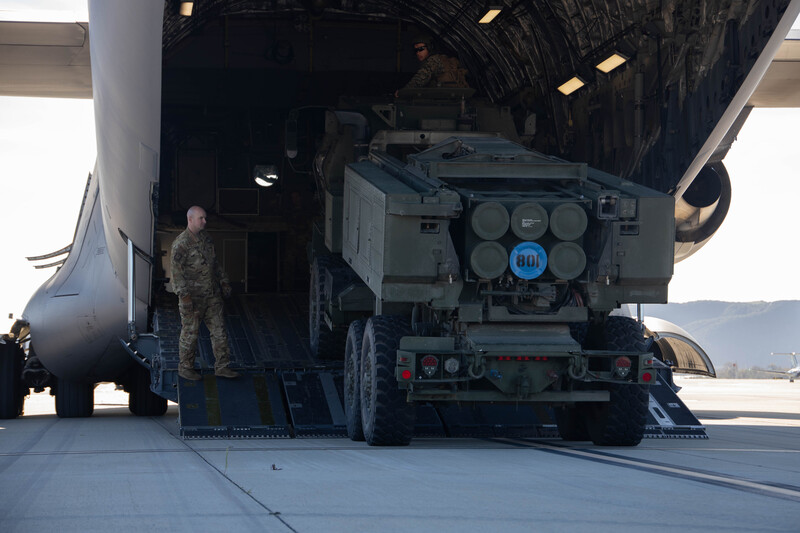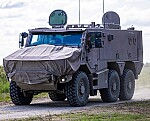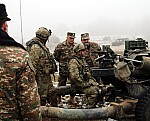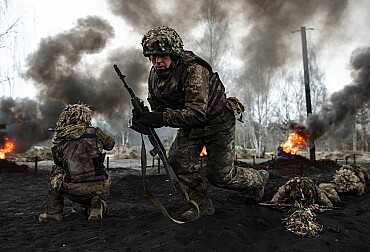A quick victory for Ukraine and stepped-up Western support are the cheapest way to end the conflict
The West should make it a priority to help Ukraine repel Russian aggression as soon as possible. Delay and cautious aid only exacerbate the problems facing the West. Boosting military support for Ukraine, which has so far been too cautious, is the only viable option to accelerate the end of the war while minimising the threat to the interests of Western countries. These are among the core conclusions of the latest report of the Jagiellonian Club Analysis Centre, "How to End the War in Ukraine? Scenarios for the End of the Conflict", by Jozef Lang.
More military support needed now
The author of the new report by the Jagiellonian Club Analysis Centre argues that a protracted conflict means markedly higher indirect costs of the conflict for Western countries as well. These costs include, among others, high energy prices, soaring inflation, and spending on refugees. The optimal long-term way to reduce or avoid these costs is to increase military support for Ukraine. This is a cheaper alternative to prolonging the conflict with limited military aid.
Since 24 February 2022, the United States – the main source of aid – has provided Ukraine with a total of nearly USD 71 billion in support, which is considerably less than the estimated costs of the wars in Iraq and Afghanistan – approx. USD 250 billion p.a. (USD 2 billion in total) and USD 115 billion p.a. (USD 2.3 billion in total), respectively.

As Jozef Lang points out, despite the enormous difference in scale, the US taxpayer's money has translated into real effects precisely in Ukraine, as Russia's offensive potential for the coming years has been clearly diminished. In this way, the security of the US's European allies has been enhanced. Kyiv, which managed to maintain the functioning of its state despite the attack, has been able to regain 45 % of the territory previously occupied by Moscow.
In the report, Lang highlights that the West's support should first focus on weapon systems that will enable attacks on strategic Russian facilities that are currently beyond the reach of Ukrainian forces.
The report does not turn a blind eye to the challenges. Fear of Russia escalating the conflict in the event of increased support for Kyiv is commonly voiced in the US and Western Europe. Lang observes that the crossing of “red lines” by the West thus far has shown the limitations of the Kremlin in challenging the determination of Western states. If escalation were to occur, it would be as a result of internal factors within Russia and not as a direct response to Western actions.
The author stresses that a major escalation (e.g. a tactical nuclear attack on Ukrainian territory) would be very risky, not least in the context of Russia's key relationship with China, which explicitly calls for the non-use of nuclear weapons. Apart from launching a large-scale invasion of Ukraine, the Kremlin has so far avoided highly risky actions due to the potential of the West (including the US) to effectively counter Russia through various channels.
Vladimir Putin hopes that a protracted conflict will erode the West's resolve to support Ukraine before Russia loses the capacity to continue the war. Putin is trying to capitalise on the West's fears of escalation, although according to the report's author, there is no real willingness to gamble behind this rhetoric.
Deterrence is expected to be crucial as the war continues, and a weak Western response to hybrid actions would be interpreted by the Kremlin as a sign of weakness and the West's willingness to make concessions in the event of confrontation.
Moscow and Kyiv will decide on the end of the war
Jozef Lang argues that it is internal conditions, not external pressure, that will determine the length of the war. Even a substantial reduction in Western support would not be instrumental in directly persuading Kyiv to agree to freezing the conflict, and in such a scenario even a split within NATO would be possible.
The majority of Ukrainian society expects a complete Ukrainian victory – 64 % believe that Ukraine will be able to take back all territories lost after 2014 (including the Crimean Peninsula). This limits the Ukrainian decision-makers' space for compromise and is also reflected in the entire political scene, where there is a consensus to continue the war. Possible Western pressure is so far doomed to fail, as Ukrainian politicians, regardless of which party, would continue the war effort even without external support.
The author of the Jagiellonian Club Analysis Centre's report notes that the West has very limited options to force both sides to end the war – this will be decided by Kyiv and Moscow. Although Russia is seeking ways to freeze the conflict, it does not want to take a significant step backwards due to fears of losing its image internally and externally.
Directly influencing the conflict, either through military involvement or ending support for Ukraine, would be highly detrimental to the strategic interests of the West. Instead, the West can increase the costs for Russia by, among other things, supporting Ukraine.
Sanctions on Russia are key in the long run
Even if the West has no real leverage to force Moscow to end the invasion, it can heat up tensions among elites inside Russia through sanctions and restrictions. According to Lang, the disproportion between the two sides in terms of military capabilities means that Ukraine is unlikely to be able to fully regain its territories if there is no internal crisis in Russia.
As the former analyst at the Centre for Eastern Studies points out in the report, Prigozhin's failed coup in July demonstrated the polarity within the Russian elite (among others, between the Ministry of Defence and the Wagner Group), and he cites media reports of a possible – in his view – split into a “peace party” (oligarchs suffering from sanctions, e.g. WTB bank chairman Andrei Kostin), the “war party” (senior officials of the security apparatus), and the “party of silence” (technocrats, e.g. Prime Minister Mikhail Mishustin). At the same time, he emphasises that the links between the key actors inside Russia are unclear and are based mainly on business interests and personal relationships.
Despite the fact that the Kremlin has so far managed to withstand the economic instruments of external pressure and maintain liquidity, the long-term costs of the invasion are increasing for Russia.
The author argues that even budget subsidies from drained reserves and elevated prices for exported energy products cannot, in the long term, limit the decline in GDP caused by sanctions and the withdrawal of some Western corporations. In 2022, Russia suffered a budget deficit of USD 45 billion instead of a projected surplus of USD 17.7 billion. Russia will also face a deficit this year – the deficit for the first seven months was USD 28.44 billion.
The aforementioned figures translate into the functioning of Russian society. Early in the year, as many as 65 % of Russians surveyed stated that their standard of living had decreased compared to the previous year. Even civil unrest in Russia is unlikely to result in a decline in the current popularity of nationalist and militaristic attitudes. On the contrary, it can even reinforce such attitudes.
What carries even more weight from the perspective of end-of-war scenarios is that since 24 February 2022, according to Western estimates, Russian oligarchs may have lost up to USD 94 billion. It is the suddenly visible tensions within the elite that are more likely to fuel a political crisis in Russia than the actions of a mostly passive Russian public.
More support for more reform
However, Lang makes it clear that support for Ukraine should follow the principle of “more for more”. Increased aid should require more progress on internal reforms.
Western societies and elites are increasingly showing signs of becoming fatigued by the very assertive stance of Ukrainian politicians towards their allies. The slow pace of reforms implemented by Ukrainian politicians is justified by the ongoing war.
In order to succeed, it is necessary to cooperate and communicate with the Ukrainian public, which is highly supportive of joining Western structures (85 % are in favour of joining the EU). At the same time, 77 % point to corruption (the third largest result).
Jozef Lang proposes that one of the transmission belts should be the media in Ukraine, which would also be sponsored by the West and would be free from the influence of oligarchs.
What is the most likely scenario?
The key factors determining the fate of the war will be the ability of the Ukrainian Armed Forces to successfully defeat the Russian army and regain control of Ukrainian territories, the sustainability of Western support for Ukraine, and internal developments in the Russian Federation. It is these factors that should be taken into consideration when projecting possible scenarios.
The most probable scenario for the coming months, as presented in the report “Jak zakończyć wojnę na Ukrainie? Scenariusze zakończenia konfliktu” [How to End the War in Ukraine? Scenarios for the End of the Conflict], is the continuation of the current dynamic of the conflict. This, however, does not mean that it will be static, as both sides will suffer the military, economic, and social costs of the conflict, which will affect the future of the Russian invasion.










